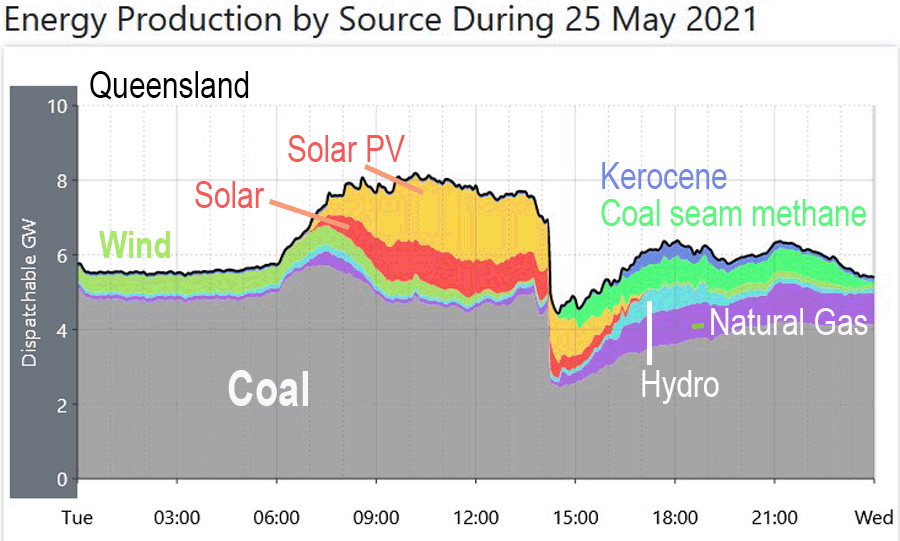Tuesday was a wild day for Queensland Electricity. An explosion struck the Callide C Power Plant triggering a cascade of other plants to switch off within seconds. The massive 2.5GW fall in supply took the grid frequency in Brisbane to a hair raising 49.55Hz. How close did it come to falling over? Half a million people lost power for a couple of hours but a Statewide blackout was averted. Luckily no one was hurt.
Meanwhile the people in power were not saying “Hydrogen”, or “explosion” but the Supercritical Units at Callide are cooled with hydrogen, and there was an explosion. The owner CS Energy called it just “a fire”. But in other news reports people in the nearest town said it was “the loudest explosion they have ever heard”.
Hydrogen, it seems, is used in some coal plants as a coolant, but Holy Hindenberg, it is known to explode. (See Ohio in 2007, Pittsburg in 2017 and India, 2019) . A Union official said it appeared the hydrogen filled generator of the main turbine had suffered a catastrophic failure. And it’s all exquisitely awkward, as David Archibald points out, happening while a two day Hydrogen Conference is on — as we speak — to sell us a half billion dollar “investment” in hydrogen hubs in the hope they might change the weather. The last thing the new Hydrogen-hopeful-industry needs is for the nation to be reminded of how explosive the first element of the periodic table is. It’s not too good for Scott Morrison either, who is selling the “hydrogen economy” to taxpayers.
Perhaps we should ask the Queensland Minister for Energy, Renewables and… Hydrogen?
In terms of the shaken Queensland electricity grid, TonyfromOz tells us gas power came in to save the day and carry the load. Other coal plants returned. The renewables though, were not much help. Hydro power was missing in action for a few hours until prices peaked at $14,500/MWh. Probably the delay was because the Wivenhoe dam was only 41% full, near its lowest level in a decade, and water is not-so-renewable at the start of the dry season in Queensland. Predictably, other intermittent power was also not there when we needed it. Wind power was doing not much in the lead up to the big bang, and nothing at all in the key minutes after. Solar production fell slightly after the explosion, then trailed off to nothing as solar does at that time of day.
h/t To David Archibald, TonyfromOz, plus Analitik, Ronin, Hanrahan, Dave.
CORRECTED: “Bagasse” changed to “Coal seam methane”. So many flavours of fossil fuels saved the day.

The shock that hit Queensland on May 25th around 2pm. Source: Anero.id
The Callide Power plant was first commissioned in 1965. It has 8 units that make 1.7GW of power. At the time of the explosion the Queensland grid was running at nearly 8GW.
TonyFromOz has a long post on PaPundits:
…sadly, while this was almost a catastrophe, not one of the renewable power sources contributed in any way to the recovery. But, hey, that didn’t stop the Premier, and her Ministers saying later in the evening and today that renewable power helped to keep the power on. In fact, the opposite was the case. When the power failed, then those renewables also failed as well, and none of the renewables assisted in the recovery. All the heavy lifting was done by natural gas fired plants, the dreaded fossil fuelled power plants, and they did not get a single mention from any of those politicians.
This was one of the largest power failures in the State for more than 45 years. The fact that it was not worse than what it could have been is testament to how those engineers are looking after the grid, trying their hardest to keep the power on. All of this resulted from a catastrophic accident, and the resultant blackout, while huge in nature could have been much much worse.
Why hydrogen?
Most of the newer generators use Hydrogen as a coolant inside the generator, as the low density, high specific heat and high thermal conductivity of hydrogen gas enables the highest efficiency for generators. …. As an example, if any of you wish to check, here is a link to a 61 page pdf document from the GE Company who manufacture these large scale generators. (see page 48)
To stop Hydrogen leaking it needs to be very pure and sealed so that air doesn’t get into the chamber, and hydrogen doesn’t get out.
Wind, not there when you need it
Then, as the wind fell away, wind generation in the State dropped from a total of 530MW at 7AM to a low of 88MW just before the large loss of power and the resultant blackout.
Then, and say, who would have thought, when the power failed, then so did both of those wind plants, at the same time, and they were off line for the next three hours. But really, 88MW of power was never going to help when almost 2800MW of power was lost. This is just another of those numerous occasions where wind generation fails to deliver when its needed.
Here’s a handy Engineer Training lesson on how to use Hydrogen to cool generators.